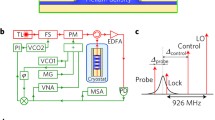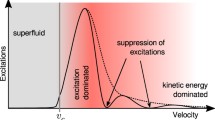Abstract
We report the characteristics of a flux locked, superfluid 4He interferometer that can continuously measure time-varying rotation rates. We describe the principles underlying the interferometer, including the dynamics of a superfluid chemical potential battery used to obtain continuous operation. We also discuss noise and drift issues and their possible amelioration.





Similar content being viewed by others
Notes
One exception to this rule is the so-called Helmholtz mode (the fundamental mode for small oscillations of the superfluid in the apertures), which does behave as an attractor.
Y. Sato, personal communications (pertaining to experiments in Ref. [12]).
See Sect. 9 for a discussion on issues related to such continuous reorientation.
The duration of a timeseries chunk is chosen to be long enough to include several tens of whistle cycles for accurate FFT results and can be made smaller when the battery state is dialed higher in frequency.
National Instruments Labview software.
Renco Encoders Inc. model E-series optical encoder.
In practice, about half this value seems to work well to avoid feedback oscillations.
We can call this a lower bound for the effective slew rate for this device at the present time, since this maximum value occurs during the fastest cryostat reorientation rate (∼9 deg/min) that we have been able to sustain under the temperature regulation and battery stability constraints noted in Sect. 9.
See Sect. 4 for details.
BearingsOn UCF215-48 flange-mounted 3 inch diameter bearing.
Up to some maximum cryostat rotation rate on the order of tens of deg/min, which is determined by the specifics of the experiment (cabling, weight distribution, etc.).
References
Y. Sato, R.E. Packard, Rep. Prog. Phys. 75, 016401 (2012)
A. Joshi, Y. Sato, R. Packard, J. Phys. Conf. Ser. 150, 012018 (2009)
E. Hoskinson, Y. Sato, I. Hahn, R.E. Packard, Nat. Phys. 2, 23 (2006)
H.A. Chan, M.V. Moody, H.J. Paik, Phys. Rev. D 35, 3572 (1987)
L.A. Page, Phys. Rev. Lett. 35, 543 (1975)
S.A. Werner, J.L. Staudenmann, R. Colella, Phys. Rev. Lett. 42, 1103 (1979)
Y. Sato, A. Joshi, R. Packard, Phys. Rev. Lett. 98, 195302 (2007)
Y. Sato, A. Joshi, R. Packard, Appl. Phys. Lett. 91, 074107 (2007)
D.R. Tilley, J. Tilley, Superfluidity and Superconductivity, 3rd edn. (Institute of Physics, Bristol and Philadelphia, 1990), pp. 79–80
E. Hoskinson, R.E. Packard, T.M. Haard, Nature 433, 376 (2005)
E. Hoskinson, R.E. Packard, Phys. Rev. Lett. 94, 155303 (2005)
Y. Sato, Phys. Rev. B 81, 172502 (2010)
E. Hoskinson, Y. Sato, K. Penanen, R.E. Packard, AIP Conf. Proc. 850, 117 (2006)
K. Penanen, T. Chui, in APS March Meeting, L15.007 (2004)
D.D. Coon, M.D. Fiske, Phys. Rev. 138, A744 (1965)
R.W. Simmonds, A. Loshak, A. Marchenkov, S. Backhaus, S. Pereversev, S. Vitale, J.C. Davis, R.E. Packard, Phys. Rev. Lett. 81, 1247 (1998)
R.W. Simmonds Ph.D. thesis, University of California at Berkeley (2002), p. 139
O. Avenel, P. Hakonen, E. Varoquaux, Phys. Rev. Lett. 78, 3602 (1997)
Y. Sato, R. Packard, Physica E 43, 702 (2011)
S. Narayana, Y. Sato, Phys. Rev. Lett. 106, 255301 (2011)
Y. Sato, A. Joshi, R. Packard, Phys. Rev. B 76, 052505 (2007)
Y. Sato, A. Joshi, R. Packard, Phys. Rev. Lett. 101, 085302 (2008)
Acknowledgements
This work was supported by the National Science Foundation (DMR 0902147). Aperture arrays were fabricated at the Cornell Nanoscale Facility, a member of the National Nanotechnology Infrastructure Network, which is supported by the National Science Foundation (Grant ECS-0335765). They were cleaned and imaged in the Molecular Foundry at Lawrence Berkeley National Laboratory (supported by the Office of Science, Office of Basic Energy Sciences, of the U.S. Department of Energy under Contract No. DE-AC02-05CH11231). We are grateful for laboratory assistance by Yashwant Gowda and helpful discussions with Yuki Sato. We would also like to thank Michael Ray for joint previous work in exploring the dynamics of the chemical potential battery in a SHeQUID and for building and testing the high resolution thermometer that we use for temperature regulation.
Author information
Authors and Affiliations
Corresponding author
Rights and permissions
About this article
Cite this article
Joshi, A., Packard, R. A Continuously Operating, Flux Locked, Superfluid Interferometer. J Low Temp Phys 172, 162–174 (2013). https://doi.org/10.1007/s10909-013-0857-y
Received:
Accepted:
Published:
Issue Date:
DOI: https://doi.org/10.1007/s10909-013-0857-y




